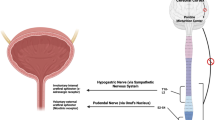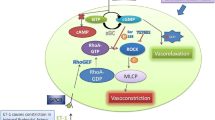Abstract
Objectives
Stress urinary incontinence (SUI) is defined as urinary incontinence that occurs with coughing, sneezing, and physical exercise. It is frequently observed in women after middle age and has a negative impact on their sexual function. Duloxetine as one of the Serotonin–noradrenaline reuptake inhibitors (SNRIs) is commonly used in the non-surgical treatment of SUI. The aim of our study is to investigate the effect of duloxetine, which is used in the treatment of SUI, on sexual functions in female patients.
Methods
The study included 40 sexually active patients who received duloxetine 40 mg twice a day for the treatment of SUI. All patients had female sexual function index (FSFI), Beck’s depression inventory (BDI), and incontinence quality of life score (I-QOL) applied before and 2 months after starting duloxetine treatment.
Results
FSFI total score significantly increased from 19.9 to 25.7 (p < 0.001). In addition, significant improvement was observed in all sub-parameters of FSFI, including arousal, lubrication, orgasm, satisfaction, and pain/discomfort (p < 0.001, for each FSFI subtotal score). BDI significantly decreased from 4.5 to 1.5 (p < 0.001). I-QOL score significantly increased from 57.6 to 92.7 after the duloxetine treatment.
Conclusions
Although SNRIs carry a high risk of sexual dysfunction, duloxetine may have an indirect positive effect on female sexual activity, both through its stress incontinence treatment and its antidepressant effect. In our study, Duloxetine, one of the treatment options for stress urinary incontinence and an SNRI, has a positive effect on stress urinary incontinence, mental health, and sexual activity in patients with SUI.
Similar content being viewed by others
Data availability
The data that support the findings of this study are openly available in the Figshare Repository at https://figshare.com/s/78ff8eacd0dc5ac9e713.
References
D’Ancona C, Haylen B, Oelke M, Abranches-Monteiro L, Arnold E, Goldman H, Hamid R, Homma Y, Marcelissen T, Rademakers K, Schizas A, Singla A, Soto I, Tse V, de Wachter S, Herschorn S, Standardisation Steering Committee ICS and the ICS Working Group on Terminology for Male Lower Urinary Tract & Pelvic Floor Symptoms and Dysfunction (2019) The international continence society (ICS) report on the terminology for adult male lower urinary tract and pelvic floor symptoms and dysfunction. Neurourol Urodyn 38(2):433–477. https://doi.org/10.1002/nau.23897
Milsom I, Gyhagen M (2019) The prevalence of urinary incontinence. Climacteric 22(3):217–222. https://doi.org/10.1080/13697137.2018.1543263
Hu JS, Pierre EF (2019) Urinary incontinence in women: evaluation and management. Am Fam Physi 100(6):339–348
Çayan S, Yaman Ö, Orhan İ, Usta M, Başar M, Resim S, Aşcı R, Gümüş B, Kadıoğlu A (2016) Prevalence of sexual dysfunction and urinary incontinence and associated risk factors in Turkish women. Eur J Obstet Gynecol Reprod Biol 203:303–308
Denisenko AA, Clark CB, D’Amico M, Murphy AM (2021) Evaluation and management of female urinary incontinence. Can J Urol 28(S2):27–32
Garely AD, Noor N (2014) Diagnosis and surgical treatment of stress urinary incontinence. Obstet Gynecol 124(5):1011–1027. https://doi.org/10.1097/AOG.0000000000000514. (Erratum.In:ObstetGynecol.2015Mar;125(3):743)
Mariappan P, Ballantyne Z, N’Dow JM, Alhasso AA (2005) Serotonin and noradrenaline reuptake inhibitors (SNRI) for stress urinary incontinence in adults. Cochrane Database Syst Rev 3:CD004742. https://doi.org/10.1002/14651858.CD004742.pub2
Pang H, Lv J, Xu T, Li Z, Gong J, Liu Q, Wang Y, Wang J, Xia Z, Li Z, Li L, Zhu L (2022) Incidence and risk factors of female urinary incontinence: a 4-year longitudinal study among 24 985 adult women in China. BJOG 129(4):580–589. https://doi.org/10.1111/1471-0528.16936
Chow PM, Chuang YC, Hsu KCP, Shen YC, Liu SP (2022) Impact of female stress urinary incontinence on quality of life, mental health, work limitation, and healthcare seeking in China, Taiwan, and south Korea (LUTS Asia): results from a cross-sectional, population-Based Study. Int J Womens Health 28(14):1871–1880. https://doi.org/10.2147/IJWH.S383651
Su CC, Sun BY, Jiann BP (2015) Association of urinary incontinence and sexual function in women. Int J Urol 22(1):109–113
Kamalak Z, Köşüş A, Hızlı F, Köşüş N, Hızlı D, Kafalı H (2014) Does quality of female sexual function improve after a trans obturator tape procedure? J Obstet Gynaecol 34(6):512–514
Burzyński B, Kwiatkowska K, Sołtysiak-Gibała Z, Bryniarski P, Przymuszała P, Wlaźlak E, Rzymski P (2021) Impact of stress urinary incontinence on female sexual activity. Eur Rev Med Pharmacol Sci 25(2):643–653
Mota RL (2017) Female urinary incontinence and sexuality. Int Braz J Urol 43(1):20–28. https://doi.org/10.1590/S1677-5538.IBJU.2016.0102
Aslan G, Koseoglu H, Sadik O, Gimen S, Cihan A, Esen A (2005) Sexual function in women with urinary incontinence. Int J Impot Res 17:248–251
Salonia A, Zanni G, Nappi RE, Briganti A, Deho F, Fabbri F, Colombo R, Guazzoni G, Di Girolamo V, Rigatti P, Montorsi F (2004) Sexual dysfunction is common in women with lower urinary tract symptoms and urinary incontinence: results of a cross sectional study. Eur Urol 45:642–648
Achtari C, Dwyer PL (2005) Sexual function and pelvic disorders. Best Pract Res Clin Obstet Gynaecol 19:993–1008
Rodrigues-Amorim D, Olivares JM, Spuch C, Rivera-Baltanás T (2020) A Systematic review of efficacy, safety, and tolerability of duloxetine. Front Psychiatr 11:554899. https://doi.org/10.3389/fpsyt.2020.554899
Rosen R, Brown C, Heiman J, Leiblum S, Meston C, Shabsigh R et al (2000) The female sexual function index (FSFI): a multidimensional self-report instrument for the assessment of female sexual function. J Sex Marital Ther 26:191–208
Wiegel M, Meston C, Rosen R (2005) The female sexual function index (FSFI): cross-validation and development of clinical cutoff scores. J Sex Marital Ther 31(1):1–20. https://doi.org/10.1080/00926230590475206
Wagner TH, Patrick DL, Bavendam TG, Martin ML, Buesching DE (1996) Quality of life of persons with urinary incontinence: Development of a new measure. Urol 47(1):67–71
Patrick DL, Martin ML, Bushnell DM, Yalcin I, Wagner TH, Buesching DP (1999) Quality of life of women with urinary incontinence: further development of the incontinence quality of life instrument (I-QOL). Urol 53(1):71–76
Eyigor S, Karapolat H, Akkoc Y, Yesil H, Ekmekci O (2010) Quality of life in patients with multiple sclerosis and urinary disorders: reliability and validity of Turkish-language version of incontinence quality of life scale. J Rehabil Res Dev 47(1):67–71. https://doi.org/10.1682/jrrd.2009.08.0132
Matza L, Brewster-Jordan J, Zyczynski T, Bavendam T (2006) An updated review of quality-of-life questionnaires for urinary incontinence and overactive bladder: which ones to use and why. Curr Bladder Dysfunct Rep 1(2):71–80
Beck AT, Ward CH, Mendelson M, Mock J, Erbaugh J (1961) An inventory for measuring depression. Arch Gen Psychiatr 4:561–571
Thomas HN, Neal-Perry GS, Hess R (2018) Female sexual function at midlife and beyond. Obstet Gynecol Clin North Am 45(4):709–722. https://doi.org/10.1016/j.ogc.2018.07.013
Muscatello MRA, Zoccali RA, Pandolfo G, Mangano P, Lorusso S, Cedro C, Battaglia F, Spina E, Bruno A (2019) Duloxetine in psychiatric disorders: expansions beyond major depression and generalized anxiety disorder. Front Psychiatr 25(10):772. https://doi.org/10.3389/fpsyt.2019.00772
Kearns B, Cooper K, Orr M, Essat M, Hamilton J, Cantrell A (2022) The incidence and costs of adverse events associated with antidepressants: results from a systematic review, network meta-analysis and multi-country economic model. Neuropsychiatr Dis Treat 7(18):1133–1143. https://doi.org/10.2147/NDT.S356414
Rothmore J (2020) Antidepressant-induced sexual dysfunction. Med J Aust 212(7):329–334
Pinheiro Sobreira Bezerra LR, Britto DF, Ribeiro Frota IP, Do Nascimento SL, Morais Brilhante AV, Lucena SV, Moura Brasil DM (2020) The impact of urinary incontinence on sexual function: a systematic review. Sex Med Rev 8(3):393–402. https://doi.org/10.1016/j.sxmr.2019.06.009. (Erratum in: Sex Med Rev. 2021 Jan;9(1):181. PMID: 32409182)
Preda A, Moreira S (2019) Incontinência Urinária de Esforço e Disfunção Sexual Feminina: O Papel da Reabilitação do Pavimento Pélvico [Stress urinary incontinence and female sexual dysfunction: the role of pelvic floor rehabilitation]. Acta Med Port 32(11):721–726
Lai S, Diao T, Zhang W, Seery S, Zhang Z, Hu M, Meng L, Ma T, Liu X, Wang J, Zhang Y (2020) Sexual functions in women with stress urinary incontinence after mid-urethral sling surgery: a systematic review and meta-analysis of prospective randomized and non-randomized studies. J Sex Med 17(10):1956–1970
Turgut H, Hasırcı E, Atkın MS, Okutucu TM, Ileri F, Ozdemir A, Usta SS, Sarier M (2021) Does the sexual function of the spouses change after the TOT procedure? Arch Gynecol Obstet 303(6):1489–1494. https://doi.org/10.1007/s00404-020-05920-9
Cayan F, Dilek S, Akbay E, Cayan S (2008) Sexual function after surgery for stress urinary incontinence: vaginal sling versus Burch colposuspension. Arch Gynecol Obstet 277(1):31–36
Zhang Y, Song X, Mao M, Kang J, Ai F, Zhu L (2019) Tension-free vaginal tape for the treatment of stress urinary incontinence: A 13-year prospective follow-up. J Minim Invasive Gynecol 26(4):754–759. https://doi.org/10.1016/j.jmig.2018.08.010
Felde G, Ebbesen MH, Hunskaar S (2017) Anxiety and depression associated with urinary incontinence. A 10-year follow-up study from the Norwegian HUNT study (EPINCONT). Neurourol Urodyn 36(2):322–328. https://doi.org/10.1002/nau.22921. (Erratum in: Neurourol Urodyn. 2020 Feb;39(2):871-872. PMID: 26584597)
Acknowledgements
The researchers would like to thank those who contributed to the completion of this research. I would like to thank the University of Mersin for giving us this learning opportunity that helped us develop valuable life lessons of patience, perseverance, teamwork, resilience, cooperation, and most of all, the endless pursuit of knowledge. Finally, our thanks go to all the people who have supported us to complete the research work directly or indirectly.
Funding
The authors declared that this study received no financial support.
Author information
Authors and Affiliations
Contributions
MB: project development, manuscript writing/editing. EK: data collection. MS: manuscript writing/editing. SŞ: data analysis. SÇ: manuscript writing/editing. EA: data analysis.
Corresponding author
Ethics declarations
Conflict of interest
No conflict of interest was declared by the authors.
Ethical approval
Informed consent was obtained from the patient for the publication of this report, and confidentiality was assured. Approval for this study was obtained from the University of Mersin School of Medicine Clinical Research Ethics Committee with the decision numbered 2023/40 on 18th of January, 2023.
Consent to participate
The data supporting this study's findings are available on request from the corresponding author. Informed consent was obtained from all individual participants included in the study.
Consent to Publish
The authors affirm that human research participants provided informed consent for the publication of personal information.
Additional information
Publisher's Note
Springer Nature remains neutral with regard to jurisdictional claims in published maps and institutional affiliations.
Rights and permissions
Springer Nature or its licensor (e.g. a society or other partner) holds exclusive rights to this article under a publishing agreement with the author(s) or other rightsholder(s); author self-archiving of the accepted manuscript version of this article is solely governed by the terms of such publishing agreement and applicable law.
About this article
Cite this article
Biyikoglu, M., Kettas, E., Sesli, M. et al. The effect of duloxetine on female sexual functions in the treatment of stress incontinence. Arch Gynecol Obstet 308, 1037–1042 (2023). https://doi.org/10.1007/s00404-023-07123-4
Received:
Accepted:
Published:
Issue Date:
DOI: https://doi.org/10.1007/s00404-023-07123-4




